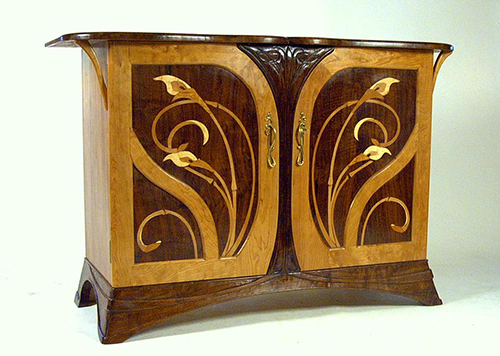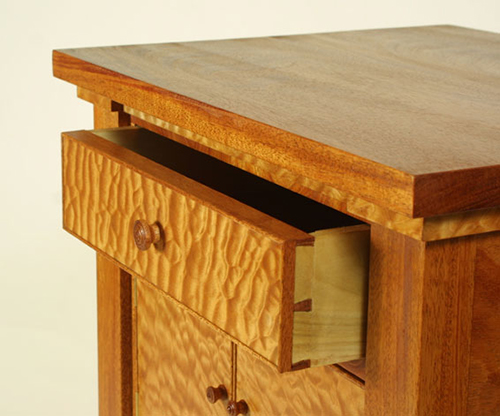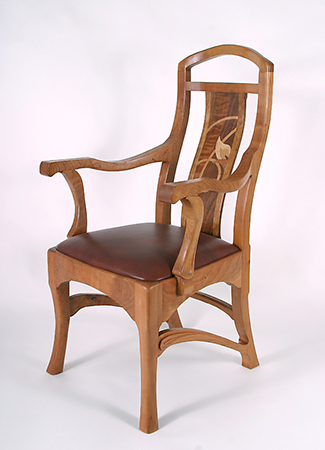
Somewhere along the way, woodworking became John Louchheim’s passion. As a kid, he whittled and even hand-carved wooden knives on his family’s driveway. Then when he was 12, he helped the guy working on his parents’ house and got started in carpentry. While he was studying biology at the University of Vermont, he took a small course in woodworking. Though knowing little about joinery, he built a couple of pieces of furniture, and even entered them in an art show! Upon graduating, rather than pursuing higher degrees in biology, he started working as a carpenter. Then after traveling with his wife, Lindsey, for a time, he returned to Vermont determined to do something creative.
“Both my wife and I knew that I wouldn’t be satisfied with a desk job,” John recalled. ” Carpentry was good, but I knew it would wear out my body a lot faster. There is less money in it, but I thought woodworking could be my lifelong endeavor. So I applied to the Furniture Institute in Massachusetts. Phil Lowe [the Institute’s founder] usually does traditional period pieces, but he let me be creative, and I learned the fundamentals of joinery.”
John was able to line up a couple of jobs right away, and the couple set up shop in Grand Isle, Vermont, about twenty-five minutes northwest of Burlington. Working mostly on commissions in a shop right next to his house, John keeps his overhead costs low.

John’s wife, Lindsey, is also an artist and plays a large part in the design process. “She has a really good eye for almost anything.” John explained, “And we work together when we do the design process.”
John’s interest in organic shapes in much of his work is reminiscent of Art Nouveau furniture. ” I like a lot of geometrical stuff, too,” John noted, ” I don’t like too roundy-round. So I lean towards Macintosh [Charles Rennie Mackintosh, late 19th and early 20th Century designer who combined traditional Scottish furniture with the flourish of Art Nouveau and the simplicity of Japanese forms], one of my favorites. We are trying to find our own style, I guess.”
The design process is probably the most stressful time for John. Starting with organic shapes and often incorporating asymmetrical curves, John works with the design until it clicks with him, then creates sketches of the finished piece. Drawings are often e-mailed back and forth with the client. It’s a time-consuming process and can take up to a week. And unless they bring in a picture of what they want, John has started charging a design fee.
“Once we decide on a design, I send a cost proposal, and that is pretty much the contract. I usually ask for half of the cost as a down payment. Then I do a full-size drawing showing all the joinery, make the patterns, purchase the wood, and get going.”
John uses power tools to rough-out the shapes, then turns to hand and carving tools for most of his work. When construction doesn’t go exactly as planned John may go back to the drawing and tweak the original design, but for some pieces he has to draw the line.
“It depends on how much money and time I have into it, but sometimes you just have to stop, throw it in the fire and start over.”
Living somewhat off the beaten path could make finding customers a challenge. But John has been able to publicize his work through press releases, a brochure, and ads in Vermont magazine. And he’s currently working on a set of chairs that he might enter in a show or display in a high-traffic retail area.
“I know I’d get more commissions in a market like New York City or Philadelphia, but the cost of living, the cost of a shop, and other factors outweigh the advantages. By advertising in Vermont magazine, I’m reaching subscribers in Connecticut and New York who have homes up here. And many people associate high-quality crafts with Vermont, and they are willing to go the extra distance or order from afar.”

It’s paid off. John’s currently working on a set of six chairs and has eight more lined up next. They’ll be in the Art Nouveau style and feature marquetry on the front and back. As more high-end jobs come his way, John would like to move into a larger space and perhaps take on a partner. But he’ll be cautious about any changes.
“Right now, I like that I am my own boss and the responsibility that comes with that. Shaping wood and being able to see something through from start to finish is probably my favorite thing in the world. I know the process of making six chairs is kind of like a production mode, but it’s still just me in a small shop and it is easier to do that. And when the machines aren’t running I like the quiet and having the time to just be myself.”
Visit Louchheim Design for more information on John and Lindsey.





